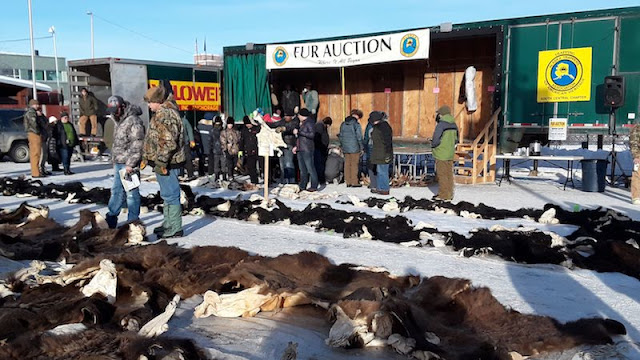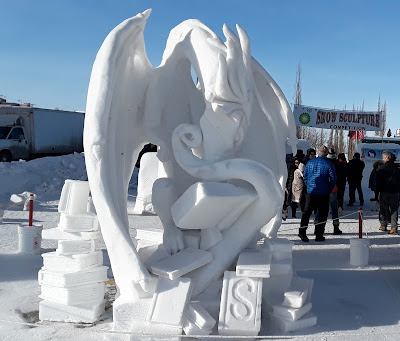 |
| In 2019, Roger and I attended the annual winter festival in Anchorage, Alaska, known as Fur Rondy. |
February 23-24, 2019
Our friend, Troy, was hiking when his friend whispered, “Stop.” Instinctively, Troy knew that his friend had seen a bear. Not just any bear, but a Southeast Alaska Island brown bear. Brown bears in Southeast Alaska and Kodiak are grizzly bears but are generally bigger than grizzlies found in the interior of Alaska and the lower 48. The brown bears typically grow larger because of the prevalence of protein-rich salmon in their diets. Troy was alert and prepared because he knew that only brown bears inhabited the island where they were hiking.
Through the trees, the friend saw just the hump of a brown bear’s back across the top of a tree hollow. The bear had been sleeping. Troy chambered a round in his rifle just as the bear rose from behind the tree. The aggravated bear looked up the trail; it looked down the trail, homed in on the two men, lowered its head, and charged.
 |
| An Alaska brown bear paw. |
Troy dropped to one knee, aimed, and pulled the trigger. He had only seconds to react. The bear was a mere twenty feet away. Fortunately, he had good aim. The bullet went through the bear’s neck and down its artery, dropping it immediately.
We ran into Troy at the 2019 State of Alaska Hide and Horn auction, part of the annual Fur Rendezvous held in Anchorage. Fur Rondy or just Rondy, began in 1935 when Anchorage had just 3,000 residents. The first winter festival was scheduled when miners and trappers usually came to town to sell their bounty. Today, the festival celebrates history and culture, provides entertainment, and attracts tourism.
While nearly all bears in Alaska are harvested by legal hunting, regulations allow a person to kill a bear in “defense of life or property.” However, the person may not keep the bear and must file a report and surrender the bear’s skull and hide to the Alaska Department of Fish and Game. In Troy’s case, he and his friend had to stop what they were doing, remove the hide and skull of the bear, and deliver them to ADFG. Not an easy task. According to ADFG, a brown bear hide can weigh 100 pounds, and the skull can add another 25 pounds.
Troy was hoping to reunite with the bear he had killed—well, with the hide of the bear anyway. |
| Auction goers preview brown and black bear hides at the annual Hide and Horn Auction. |
Anticipating that the hide from the bear he killed would be at the Hide and Horn Auction, Troy flew to Anchorage, intending to bring it home. ADFG does not track the hides, and Troy identified the one he had shot among the more than 100 hides by using photos he had taken of identifying marks on the paws, the location of the bullet hole in the neck, as well as the color and size of the hide. Other bidders were also interested in this hide because of its condition, size, and dense hair. Ultimately his high bid of over $800 was accepted, and he was declared the winning bidder and was awarded the bear hide.
Once a year, ADFG sends hides from defense-of-life-and-property kills, such as Troy’s, as well as others from roadkill and those that have been confiscated from poachers or other illegal hunters to Anchorage, where the South Central Chapter of the Alaska Trappers Association organizes a fur auction.
 |
| A Dall’s sheep cape is ready for auction. According to the National Park Service, “Dall’s sheep inhabit some of Alaska’s most rugged alpine areas.” |
This auction is the only opportunity for people to legally purchase animal hides in Alaska and attracts collectors worldwide. This auction benefits wildlife, hunting, and education programs of both ADFG and the Alaska Trappers Association.
 |
| “Not All Treasures Are Gold” carved by AK Awesome. |
During our final visit to the auction, we witnessed Troy’s successful bid on the hide, waited for him to claim it after the end of the auction, and helped him get it into his truck. (FYI—not only are bear hides heavy, they also stink!) Troy already had a taxidermist lined up to process the hide, so we quickly said our goodbyes, and he was on his way.
Don’t let the cold Alaska winter keep you from attending Fur Rondy. You can enjoy outdoor winter activities when you dress appropriately for the conditions. If you have real animal fur garments, Anchorage is the place to wear them. Fur Rondy is one of the few places where it is still acceptable to wear animal fur.
 |
| Rondy Royalty 2019 |
NOTES: Thank you, Troy, for permission to include your bear story in this article. Every day I am thankful for my husband, travel partner, editor, and proofreader, Roger.